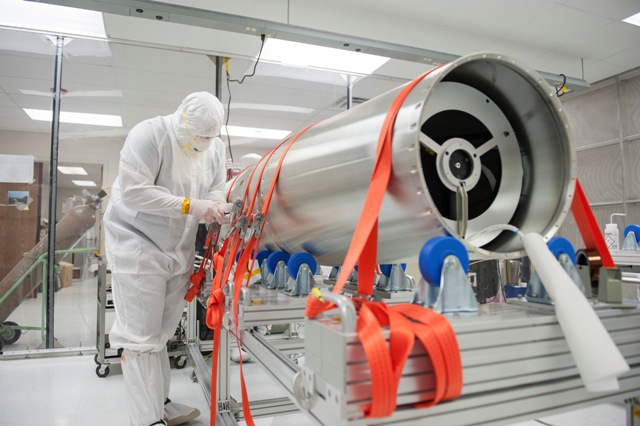Sep 4 2015
Conducting science in space is never simple. Imagine trying to study a specific region of the sun, for example, from a vantage point some 93 million miles away, probing that area at a level of precision less than 0.1 percent -- with less than five minutes to do the job.
 A NASA worker in a clean room at the National Space Science Technology Center in Huntsville, Alabama, checks out the CLASP instrument prior to shipping to White Sands Missile Range in New Mexico for its Sept. 3 launch. Credits: NASA/MSFC
A NASA worker in a clean room at the National Space Science Technology Center in Huntsville, Alabama, checks out the CLASP instrument prior to shipping to White Sands Missile Range in New Mexico for its Sept. 3 launch. Credits: NASA/MSFC
That's the task facing scientists preparing to launch NASA's CLASP instrument, a joint effort between the United States, Japan, Spain and France, to the edge of space on September 3. CLASP is shorthand for the Chromospheric Lyman-Alpha Spectro-Polarimeter, a high-tech telescope that will obtain unprecedented observations during that tiny window of opportunity, when it will study the sun for some 300 seconds.
During that time, scientists anticipate CLASP will deliver the first-ever measurement of the magnetic field in the sun's middle layers, the upper chromosphere and the transition region. To accomplish this, "it will measure the Hanle effect polarization of Lyman-Alpha in the solar chromosphere," said Amy Winebarger, principal investigator for CLASP and a researcher in the Science Research Office at NASA's Marshall Space Flight Center in Huntsville, Alabama.
She explained: "That's is a very technical way of saying this instrument will attempt to measure a specific wavelength of ultraviolet light emitted by hydrogen ions in this solar region, and the polarization of this light can be correlated to the intensity and direction of the magnetic field. The polarization of this specific spectral line is extremely sensitive to magnetic fields, making CLASP more effective than previous measuring methods by a factor of 100."
What's so important about that magnetic field? "It plays a crucial role in dictating the structure of the sun's atmosphere," said Winebarger's CLASP colleague, NASA astrophysicist Jonathan Cirtain. "It also acts as a conduit for mass and energy to flow into the solar corona and solar wind -- some of it heading toward us as powerful solar flares that can disrupt Earth satellites. It's critical to understand the process by which the sun releases these bursts of energy."
Winebarger, Cirtain and their team are no strangers to this research. They developed two previous sounding-rocket solar experiments, the High Resolution Coronal Imager, or Hi-C, which launched in 2012, and the Solar Ultraviolet Magnetograph Instrument, or SUMI, which completed its second research flight in 2012. Cirtain also was project scientist for Hinode, the joint Japanese-American mission launched in 2006 to study the sun. Hinode's Solar Optical Telescope conducted some of the same spectropolarimetric observations CLASP will make -- but peered much deeper into the sun's photosphere, or surface, studying more readily accessible optical light and vector magnetic fields.
CLASP owes a lot to those previous missions -- and to its international team of contributors, Winebarger said. It is based on pioneering theoretical research by Javier Trujillo-Bueno and his team at the Instituto de Astrofísica de Canarias in Santa Cruz de Tenerife, Spain. SUMI and Hi-C provided the inspiration for CLASP's optical layout, electronics and electrical interface. Its internal structure and optics were provided by the National Astronomical Observatory of Japan in Tokyo. Additional optical contributions were made by the Institut d'Astrophysique Spatiale in Paris. Finally, the cameras that will image the sun, delivering more stable, high-speed images and less noise than their predecessors, were developed in-house at Marshall by researchers in the Engineering Directorate's Space Systems Department.
The flight experiment will ride on a Black Brant IX sounding rocket launched from White Sands Missile Range in New Mexico. CLASP is supported through NASA's Sounding Rocket Program at the agency's Wallops Flight Facility on Wallops Island, Virginia, which is managed by NASA's Goddard Space Flight Center in Greenbelt, Maryland. NASA's Heliophysics Division manages the sounding-rocket program.
The mission is a joint effort between NASA, the Japan Aerospace Exploration Agency headquartered in Chofu, the Instituto de Astrofísica de Canarias and the Institut d'Astrophysique Spatiale. Additional partners include the Lockheed Martin Solar Astrophysics Laboratory in Palo Alto, California, and the University of Alabama in Huntsville.
Learn more about NASA space science and heliophysics research at www.nasa.gov.